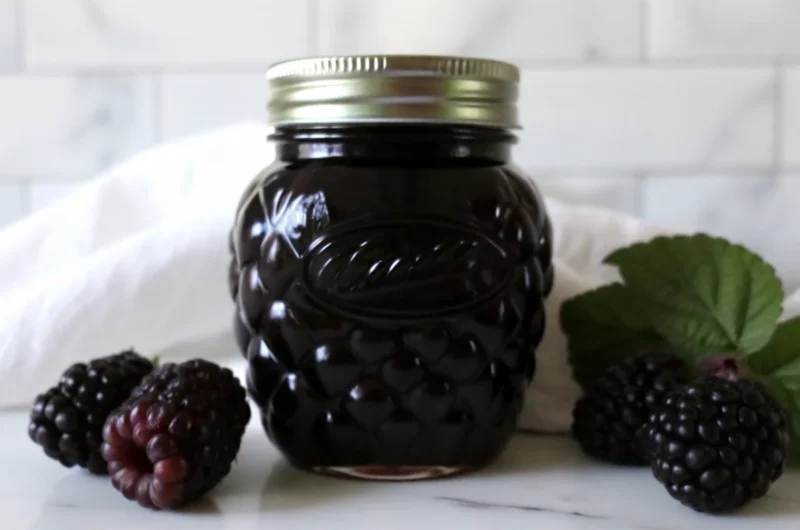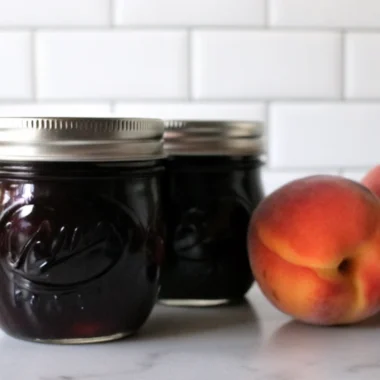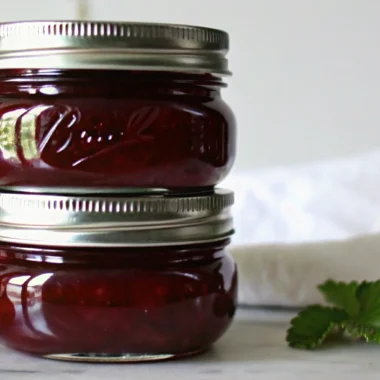Did you know that greater than 70% of the original nutrient value remains in homemade blackberry jam, even after the heating and straining process? This remarkable fact challenges the common belief that cooking destroys all the nutritional benefits of fresh fruit. Our seedless blackberry jam recipe not only preserves the vibrant flavor and deep purple color of summer blackberries but also maintains significant levels of vitamin C, B vitamins, vitamin E, vitamin K, vitamin A, and powerful anthocyanins that make blackberries true nutritional powerhouses.
Making seedless blackberry jam without added pectin connects you to traditional preservation methods while creating a smoother, more luxurious spread. This old-fashioned approach allows the fruit to maintain more of its shape and more of its freshness of flavor compared to heavily processed commercial alternatives. By relying on the natural pectin already present in your fruit, you’ll create a jam that’s both authentic and delicious.
Ingredients List
Transform 4 pounds of fresh blackberries into liquid gold with these simple, pure ingredients:
- 16 cups fresh blackberries (approximately 4 lbs) – Choose plump, deep purple berries with a slight firmness for optimal natural pectin content
- 4 cups granulated white sugar – The essential preserving agent that also helps activate natural pectin
- 2 tablespoons fresh lemon juice (optional) – Enhances flavor and aids in gelling, especially beneficial for sweeter cultivated varieties
Substitution Options:
- Sugar alternatives: You can reduce sugar to 3 cups for a less sweet jam, though this may affect setting time
- Lemon alternatives: Apple cider vinegar (1 tablespoon) can substitute for lemon juice in a pinch
- Berry variations: Mix in 1-2 cups of high-pectin berries like cranberries or tart apples for enhanced natural gelling
Timing
Preparation Time: 30 minutes
Cooking Time: 60-75 minutes
Processing Time: 10-15 minutes
Total Time: 100-120 minutes
This traditional method takes approximately 90 minutes total, which is longer than pectin-assisted recipes but preserves the fresh fruit taste and vibrant hue. The extended cooking time allows the natural sugars to concentrate and the fruit’s inherent pectin to activate properly, creating that perfect spreadable consistency.
Step-by-Step Instructions
Step 1: Prepare Your Canning Setup
Sterilize 6-7 half-pint jars in boiling water for 10 minutes. Place new lids in hot (not boiling) water and prepare your water bath canner. Keep everything hot until ready to fill – this prevents thermal shock and ensures proper sealing.
Step 2: Cook the Berries to Release Natural Pectin
Combine mashed blackberries with a small amount of water in a deep, heavy-bottomed saucepan. Bring to a gentle boil and simmer for 5 minutes, mashing continuously with a potato masher. This process helps to draw the pectin out of the fruit’s cell walls and provides the right pH environment for the pectin chains to link up effectively.
Step 3: Create Your Seedless Base
Working in batches, press the softened berries through a fine mesh strainer, chinois, or food mill fitted with a berry screen. Apply steady pressure but don’t rush – you want approximately 6 cups of smooth, seedless pulp. This step creates the luxurious texture that sets this jam apart from seeded versions.
Step 4: Balance Sugar and Acidity
Return seedless pulp to a clean jam pot and stir in 4 cups sugar plus optional lemon juice. Mix thoroughly to dissolve some sugar before heating. This 3:2 fruit-to-sugar ratio provides optimal preservation while allowing the blackberry flavor to shine.
Step 5: Achieve the Perfect Boil
Turn heat to medium-high and bring mixture to a rolling boil, stirring frequently. Use your deepest pot as seedless blackberry jam foams considerably. A long, slow boil drives the moisture out of the fruit, helping to preserve and thicken it at the same time.
Step 6: Test for Gel Stage
Boil constantly for 15-20 minutes, stirring continuously. Test doneness using the cold plate method: drop a spoonful of hot jam onto a frozen plate, let it sit for a minute, then push it with your finger. If it wrinkles and doesn’t flow back together, it’s ready.
Step 7: Finish and Fill
Remove from heat and skim foam if desired. Ladle hot jam into prepared jars, leaving ¼ inch headspace. Wipe rims clean, apply lids, and screw bands fingertip tight.
Step 8: Process for Shelf Stability
Process in boiling water bath for 10 minutes (15 minutes above 6,000 feet elevation). Remove jars and cool undisturbed for 12-24 hours before checking seals and storing.
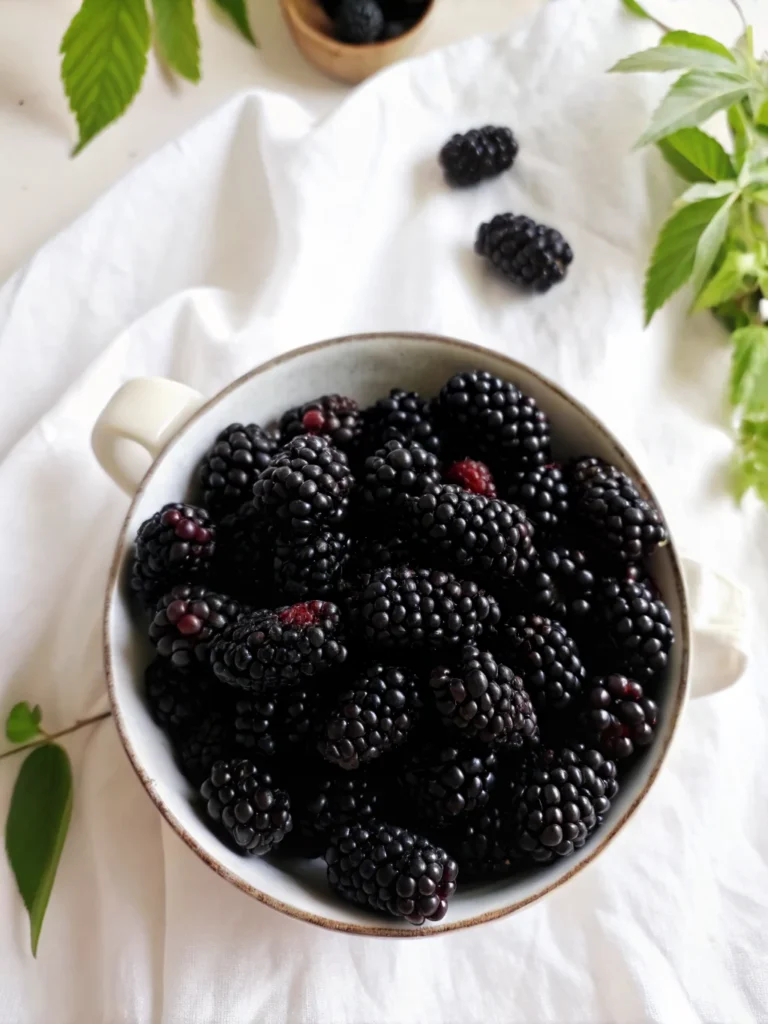
Nutritional Information
Per 1 tablespoon serving:
- Calories: 64 kcal
- Carbohydrates: 16g
- Protein: 1g
- Total Fat: 0.2g
- Saturated Fat: 0.01g
- Sodium: 0.5mg
- Potassium: 59mg
- Dietary Fiber: 2g
- Sugar: 14g
- Vitamin A: 77 IU
- Vitamin C: 8mg
- Calcium: 11mg
- Iron: 0.2mg
Key Nutritional Highlights:
Blackberries are one of the best known sources of anthocyanins (better than blueberries or blackcurrants), powerful antioxidants that support cardiovascular health and cognitive function. Blackberry jam can retain most of the fruit’s nutrients and antioxidants when prepared using traditional methods.
Healthier Alternatives for the Recipe
Reduced Sugar Version:
Replace 1 cup of white sugar with ¾ cup coconut sugar or honey for added minerals and a lower glycemic impact. Blackberries have a low glycemic index and are high in fiber, making them a great fruit option for people managing diabetes.
Natural Sweetener Options:
- Maple syrup: Use ¾ cup pure maple syrup in place of 1 cup sugar
- Date paste: Blend 1 cup pitted dates with ¼ cup water for natural sweetness
- Stevia blend: Use ½ cup sugar plus stevia equivalent to remaining sweetness
Functional Additions:
- Chia seeds: Add 2 tablespoons for extra fiber and omega-3 fatty acids
- Fresh ginger: Grate 1 teaspoon for anti-inflammatory benefits
- Vanilla extract: Add 1 teaspoon for enhanced flavor complexity
Serving Suggestions
Classic Applications:
Spread on warm buttermilk biscuits, artisanal sourdough toast, or English muffins for a traditional breakfast experience. The seedless texture makes it perfect for elegant afternoon tea service.
Gourmet Pairings:
Create sophisticated cheese plates by pairing with sharp aged cheddar, creamy brie, or tangy goat cheese. Make compotes or sauces to top pancakes or grilled meats, preserve blackberries for toast or pastries.
Creative Culinary Uses:
- Baking enhancement: Swirl into muffin batter, layer in coffee cakes, or use as pie filling
- Dessert sauces: Thin with warm water or wine for ice cream and cheesecake toppings
- Savory applications: Glaze for roasted pork, duck, or lamb dishes
- Beverage bases: Mix with sparkling water or prosecco for elegant cocktails
Common Mistakes to Avoid
Overcooking Pitfall:
Without added pectin, you need to cook the fruit mixture for a longer period, which can lead to a loss of flavor and color. Test frequently after 15 minutes to prevent overcooking.
Sugar Ratio Errors:
It is the combination of sugar, natural pectin and, for some fruits, acid (lemon juice) that causes the gel. And the sugar is the main preserving ingredient. Reducing sugar significantly can prevent proper gel formation and compromise food safety.
Temperature Misjudgments:
Avoid using candy thermometers exclusively – jam sets at 220°F at sea level, but subtract 2°F for every 1,000 feet above sea level. Always confirm with the plate test.
Processing Errors:
Don’t skip the water bath processing step. Even high-acid foods like blackberry jam require proper heat processing for safe shelf storage.
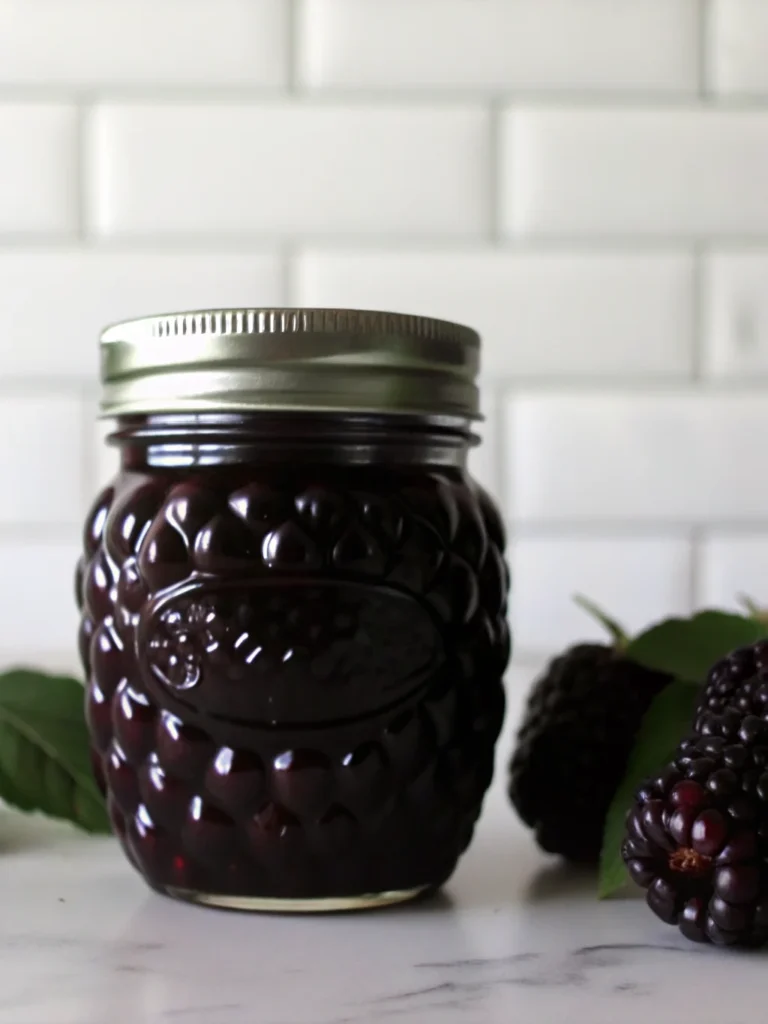
Storing Tips for the Recipe
Shelf Storage:
Properly processed jars store in cool, dark locations for up to 18 months. After opening, store it in the refrigerator and ensure the lid is tightly closed to preserve its flavor and quality. When stored correctly, opened jam can remain good for 6-12 months in the refrigerator.
Refrigerator Storage:
Unprocessed jam keeps in the refrigerator for 2-3 weeks. Keep it away from heat and light, and utilize clean utensils when serving jam to prevent contamination and prolong its freshness.
Freezer Option:
Pour cooled jam into straight-sided freezer-safe jars, leaving ½ inch headspace. It can be frozen for up to three months without significant quality loss.
Quality Maintenance:
Avoid using metal containers for storage, as they may react with the acidity and change the flavor. Always use clean spoons to prevent contamination and mold growth.
Conclusion
This seedless blackberry jam recipe celebrates the pure essence of summer blackberries through time-honored preservation techniques. By harnessing natural pectin and traditional cooking methods, you create a smooth, intensely flavored spread that maintains significant nutritional value while developing complex, concentrated flavors that commercial products simply cannot match.
Ready to transform your kitchen into a jamming paradise? Try this recipe and share your beautiful results in the comments below! Subscribe to our blog for more traditional preservation recipes, seasonal cooking tips, and homesteading wisdom that connects you to the timeless art of food preservation.
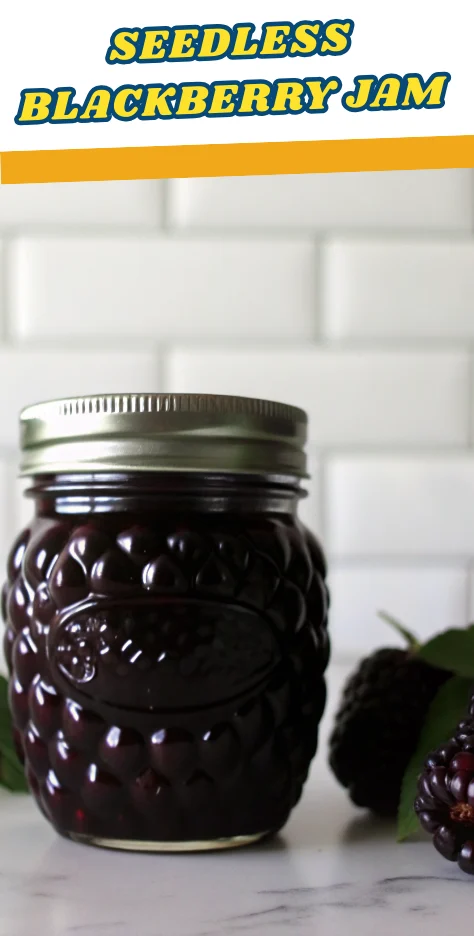
FAQs
Q: Can I make this recipe if my blackberries aren’t perfectly ripe?
A: Select firm, slightly under-ripe fruit (the best source of natural pectin) for optimal gelling. A mix of ripe and slightly under-ripe berries actually works best.
Q: Why is my jam not setting properly?
A: Making jam without added pectin relies on a perfect balance of three key elements. If one is out of whack, you’ll likely end up with syrup instead of jam. Ensure proper fruit-to-sugar ratios and adequate cooking time.
Q: Is the lemon juice really optional?
A: Blackberries are naturally high in acid, so lemon juice isn’t required for safety. However, it enhances flavor and helps with gelling, especially for sweeter commercial varieties.
Q: Can I double this recipe?
A: Cook in small batches: Cooking in small batches allows the jam to heat up more quickly and evenly, which helps to concentrate the pectin. Stick to single batches for best results.
Q: How do I know when the gel stage is reached without a thermometer?
A: Master the plate test method described in Step 6. It’s the most reliable indicator for traditional jam making and works at any altitude.
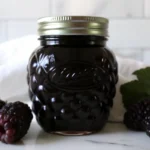
Smooth Seedless Blackberry Jam Recipe – Traditional No-Pectin Method
- Total Time: 100-120 minutes
- Yield: 6–7 half-pint jars 1x
Description
A smooth, seedless blackberry jam made without added pectin, preserving the rich flavor, vibrant color, and nutritional value of fresh summer blackberries.
Ingredients
- 16 cups fresh blackberries (about 4 lbs)
- 4 cups granulated white sugar
- 2 tablespoons fresh lemon juice (optional)
Substitutions:
- Sugar alternatives: reduce sugar to 3 cups, or use honey, coconut sugar, maple syrup, date paste, or stevia blend
- Lemon alternatives: 1 tablespoon apple cider vinegar
- Berry variations: mix in 1-2 cups high-pectin berries (cranberries, tart apples)
Instructions
- Sterilize 6-7 half-pint jars in boiling water for 10 minutes. Keep hot until filling.
- Mash blackberries with a little water in a saucepan. Simmer 5 minutes, mashing continuously.
- Press softened berries through a fine mesh strainer or food mill to remove seeds. Aim for 6 cups pulp.
- Return pulp to pot. Stir in sugar and optional lemon juice until dissolved.
- Bring to rolling boil over medium-high heat, stirring frequently.
- Boil 15-20 minutes, stirring constantly. Test gel stage with cold plate method.
- Remove from heat, skim foam. Ladle into jars leaving 1/4 inch headspace. Wipe rims, apply lids and bands.
- Process in boiling water bath 10 minutes (15 minutes above 6,000 ft). Cool 12-24 hrs before checking seals.
Notes
Test frequently to avoid overcooking. Maintain proper fruit-to-sugar ratio for safe gel. Always confirm with plate test. Don’t skip water bath processing for safe shelf storage.
- Prep Time: 30 minutes
- Cook Time: 60-75 minutes
- Category: Jam & Preserves
- Method: Canning
- Cuisine: Traditional
Nutrition
- Serving Size: 1 tablespoon
- Calories: 64
- Sugar: 14g
- Sodium: 0.5mg
- Fat: 0.2g
- Saturated Fat: 0.01g
- Unsaturated Fat: 0.19g
- Trans Fat: 0g
- Carbohydrates: 16g
- Fiber: 2g
- Protein: 1g
- Cholesterol: 0mg
